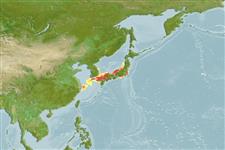Environment: milieu / climate zone / depth range / distribution range
Ecologia
marinhas demersal. Temperate
Northwest Pacific: Japan Sea off coast of northern Honshu, Japan.
Tamanho / Peso / Idade
Maturity: Lm ? range ? - ? cm
Descrição breve
Chaves de identificação | Morfologia | Morfometria
Espinhos dorsais (total) : 11 - 13; Raios dorsais moles (total) : 9 - 10; Espinhos anais: 0; Raios anais moles: 17 - 20. Closely resembles O. iburia in general appearance, but differs by having a few enlarged subpectoral plates, and 35 or fewer dorsolateral and ventrolateral plates.
Life cycle and mating behavior
Maturities | Reprodução | Spawnings | Egg(s) | Fecundities | Larvas
Masuda, H., K. Amaoka, C. Araga, T. Uyeno and T. Yoshino, 1984. The fishes of the Japanese Archipelago. Vol. 1. Tokai University Press, Tokyo, Japan. 437 p. (text). (Ref. 559)
Categoria na Lista Vermelha da IUCN (Ref. 130435)
Ameaça para o homem
Harmless
Utilização humana
Ferramentas
Relatórios especiais
Descarregue XML
Fontes da internet
Estimates based on models
Phylogenetic diversity index (Ref.
82804): PD
50 = 0.5625 [Uniqueness, from 0.5 = low to 2.0 = high].
Bayesian length-weight: a=0.00389 (0.00180 - 0.00842), b=3.12 (2.94 - 3.30), in cm total length, based on all LWR estimates for this body shape (Ref.
93245).
Nível Trófico (Ref.
69278): 3.2 ±0.3 se; based on size and trophs of closest relatives
Resiliência (Ref.
120179): Médio, tempo mínimo de duplicação da população 1,4 - 4,4 anos (Preliminary K or Fecundity.).
Fishing Vulnerability (Ref.
59153): Low vulnerability (16 of 100).
